
This artistic impression shows the universe around the star formation area with, as an overlay, the scientists’ observations.(c) Veronica Allen/Alexandra Elconin (http://alsewhere.weebly.com)
An international team of astronomers, led by Dutch scientists, has discovered a region in our Milky Way that contains many nitrogen compounds in the southeast of a butterfly-shaped star formation disk and very little in the north-west. The astronomers suspect that multiple stars-to-be share the same star formation disk, but the precise process is still a puzzle.
They studied the star forming region G35.20-0.74N, more than 7000 light years from Earth in the southern sky. The astronomers used the (sub)millimeter telescope ALMA which can map molecular gas clouds in which stars form...
Read More






Recent Comments